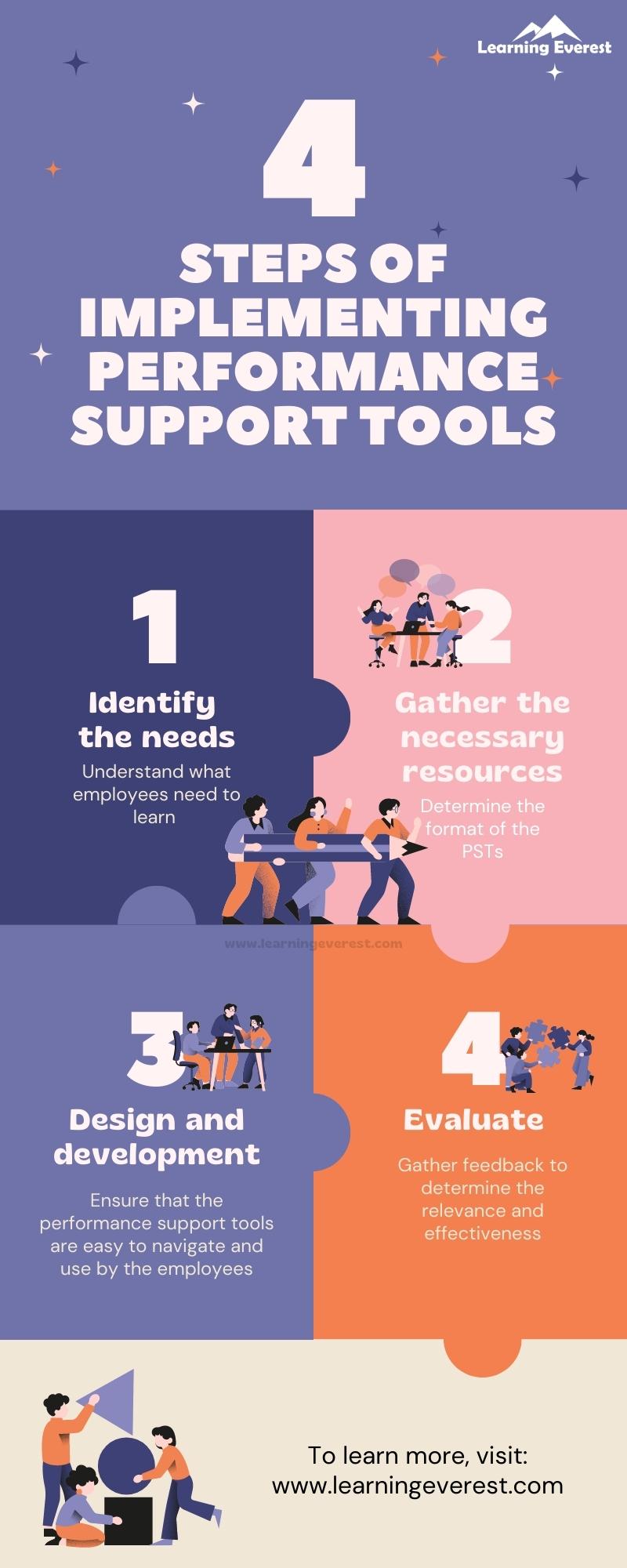Performance support is a valuable tool for employers. It is helpful to improve employees’ performance and productivity. This article will talk about how you can use performance support tools to help your employees to do their jobs more effectively.
Table of Contents
What are Performance Support Tools (PSTs)?
Performance support tools are basically aids and resources that help employees do their tasks more efficiently and effectively. These tools can come in a written or digital format. They can be software applications, checklists, infographics, or even instructional short videos. They are a form of providing just-in-time training. That means they are available when it’s needed. They can be accessed easily from anywhere, anytime. Performance support tools can be used by organizations who wants to train their employees quickly. They are helpful in fast-paced work environments where employees need to be productive.
Types of Performance Support Tools
Now, you can provide performance support tools to your employees in a variety of formats, including:
- Interactive tutorials (like, interactive videos, short branching scenarios, mobile apps, animated illustrations, podcasts, microlearning modules, and gamified learning)
- Quick reference guides (like, interactive PDFs, eBooks, infographics, checklists, and cheat sheets)
- Knowledge bases (like, FAQs, forums, and wikis)
- Learning management systems (LMSs)
Implementing any of the abovementioned formats of performance support tools is not enough. You should cater to the employees’ learning preferences before implementing performance support tools. Here is how you can implement performance support tools in your organization.
How would you implement a performance support tool?
There are a few steps to effectively implement performance support tools:
Step 1: Identify the needs
A 2015 report on workplace training by 24×7 Learning Inc. found that just 11% of employees can fully use the training in their job. This shows a significant disconnect between what the training organizations offer and what their employees need. It is crucial to understand what employees need to learn to address how employees learn. Identifying the needs includes issues related to employee and organizational performance to determine if performance support can help. It involves monitoring current performance using observation, interviews, and questionnaires.
Step 2: Gather the necessary resources
Next, it is important to determine the format of the performance support tools. It can be determined from the type and level of training the employee’s needs. This includes creating new performance support tools. You can also readjust your existing performance support tools.
Step 3: Design and development
After that, create a user-friendly interface and ensure that the performance support tools are easy to navigate and use by the employees. Moreover, they should be accessible anytime, from anywhere, regardless of the device.
Step 4: Evaluate
Next, it is essential to provide feedback from employees related to the performance support system. It contributes to determining what needs to be improved. Performance support tools promote need-related training. Feedback helps in determining the relevance and effectiveness of the training module.
Benefits of performance support tools
The key benefits of performance support tools are as follows:
- Effective: Performance support tools provide a flexible and scalable solution for various learning needs. They enable employees to quickly upskill and stay up-to-date with the latest industry trends, all while on the job.
- Consistent: Unstandardized, instructor-led training comes with limited interaction. They are difficult to cater to diverse learning styles. Also, coordinating training sessions is not cost-effective at all. In contrast, standardized performance support tools lead to consistencies in knowledge and practices across the organization.
- Easily accessible: Performance support can be delivered digitally, such as on a computer, tablet, or smartphone. They are called electronic performance support systems (EPSSs). So, they can be accessed from anywhere using the internet. This makes it convenient for employees to use.
- Relevant: To enhance the practical application, performance support tools include real-world scenarios pertinent to the job. Employees were encouraged to analyze and respond to these scenarios, thereby strengthening their problem-solving skills and facilitating active learning.
Infographic
Conclusion
To wrap up, performance support tools are an effective way to enhance employee productivity and performance. It provides on-demand access to information, instructions, and guidance. It helps employees easily upskill without relying on traditional training methods. Therefore, it is important for organizations to invest in implementing performance support tools to realize their benefits entirely.
Was this helpful?
Do you also want to leverage performance support tools for your employees?
With our performance support tools, you can access a wealth of valuable resources tailored to your organization’s specific needs. Schedule a meeting today!
Frequently Asked Questions (FAQs)
What are performance support tools?
Performance support tools are resources that help employees perform their tasks efficiently and effectively. These tools can be in the form of software applications, job aids, checklists, infographics, or instructional videos.
What is an example of an electronic performance support system?
There are a few steps involved in implementing a performance support system:
- Identify the needs of your employees,
- Gather the necessary resources,
- Design and develop the performance support tools, and
- Evaluate the performance support system.
How would you implement a performance support system?
Checklists and Job Aids can be an example of a performance support system.






